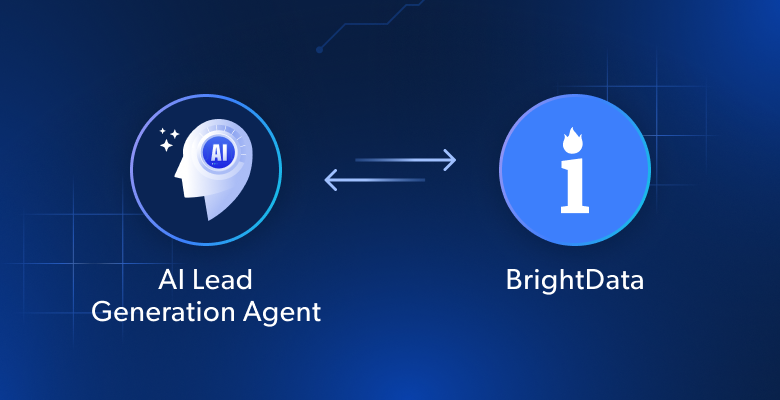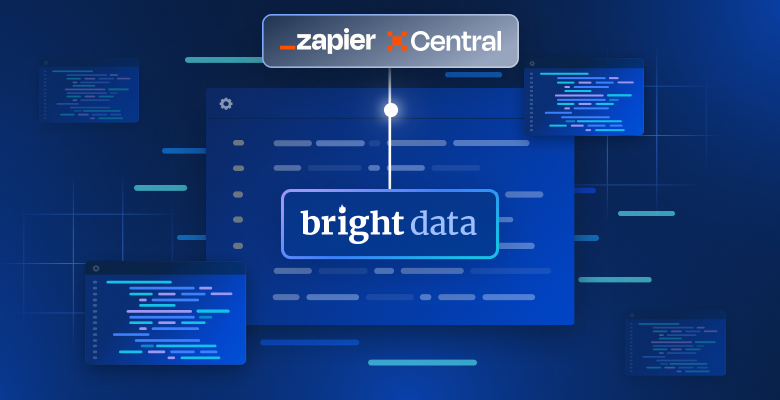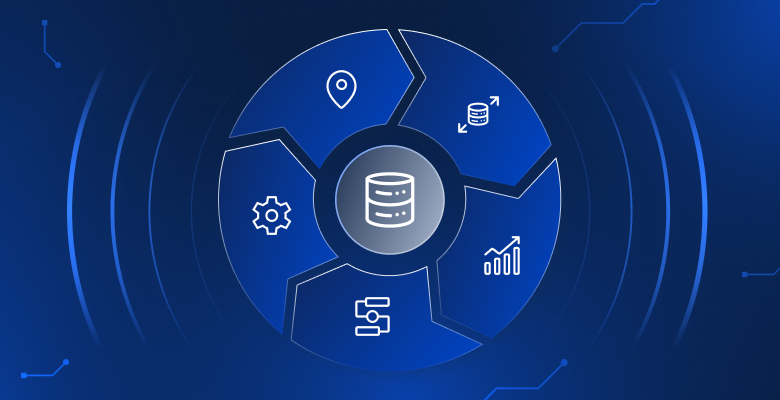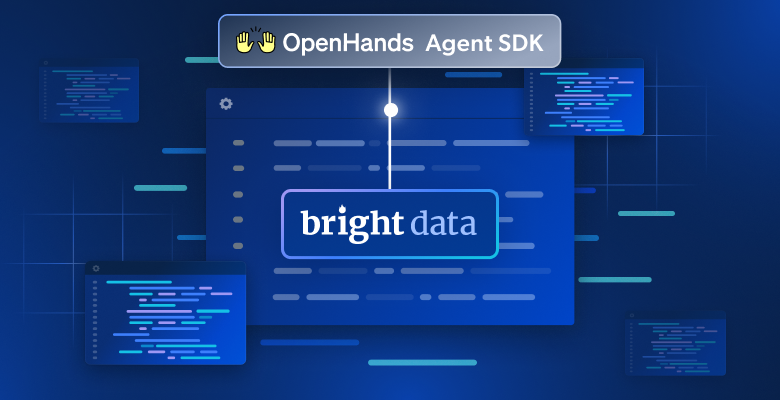Lead generation is the lifeblood of sales, but for most teams, it remains a frustrating bottleneck. Traditional approaches are slow, biased, and hard to scale, trapping your best talent in a cycle of manual searching, data entry, and guesswork. But what if you could transform this critical function from tedious chore into a seamless, automated advantage?
In this guide you will learn:
– What AI lead generation is
– Why AI beats traditional methods
– How to build your own lead generation agent step by step
– How Bright Data supercharges your workflow
Let’s Begin!
What is AI Lead Generation
In simple terms, AI Lead generation is the process of using artificial intelligence to automatically find, collect, enrich, and qualify potential customers for your business. It transforms raw data into actionable sales opportunities.
Think of it as a highly efficient, data driven sales development representative that works 24/7. It doesn’t just find leads, it understands them.
An AI agent performs a seamless, automated workflow built on four key actions:
- Scrape – It autonomously uses tools like Bright Data’s scrapers to collect raw data from targeted sources( e.g., Linkedin, Company websites). This is its method of “interacting with the external enviroment.”
- Enrich – The agent takes this raw data which is usually details of a company and uses other tools to append crucial information. It will automatically find email adresses, phone numbers, tech stack data, company funding news, and other publicly available data.
- Score – This is where the “decision making” and “problem solving” core of the AI agent shines. Using the enriched data, it qualifies a lead. For example:
- Rule-based scoring: “If industry = Technology and employee_count > 50, add 10 points.”
- LLM-powered reasoning: An LLM analyzes the lead’s profile and company news to assess fit based on a nuanced prompt describing your Ideal Customer Profile (ICP). It can comprehend complex criteria that are hard to codify with simple rules.
- Engage: Finally, the agent performs an action. It doesn’t just stop at analysis. It can automatically add the qualified lead to a CRM, generate a personalized outreach email, or even send a first touch message on another platform, closing the loop from discovery to first contact.
Why Traditional Lead Generation Fails Short
For decades, the sales process for lead generation has remained largely manual. A sales rep manually searches for prospects, judges their potential based on limited information, and hopes their follow up lands in a busy inbox at the right time. This approach isn’t just outdated, it’s fundamentally flawed. Here’s why traditional methods are failing your sales team:
1.Human Bias in Qualification: The manual process relies heavily on gut feelings and subjective judgements. A rep might unconsciously prioritize leads from familiar companies or specific roles.
2.Leads Slipping Through the Cracks: Manual lead generation is a chaotic process of switching between tabs, spreadsheets, and CRM entries. It’s inevitable that promising leads get lost in messy Excel sheets, forgotten in browser tabs, or never get entered into the system in the first rush of activity. Every lead that slips away is revenue directly leaving your funnel.
3.Limited Availability of Teams: Your sales team can only work 40 hours a week(if you are lucky). They need sleep, vacations, and weekends. The internet, however, does not. Potential customers are researching solutions at all hours, but your manual process can only respond during business hours. This
Why AI Lead Generation Matters
AI powered lead generation is not just an upgrade, it is a complete transformation of the sales process. It matters because it directly the core failures of traditional methods by giving:
- Total Automation: It handles the repetitive, time intensive tasks of searching and data collection, freeing your team to focus on closing deals.
- 24/7 Operation: Unlike a human team, an AI agent works around the clock, ensuring no opportunity is missed due to time zones.
- Data-Driven Decisions: It replaces human guesswork and bias with objective, criteria based qualification, ensuring you only pursue the highest potential leads.
- Instantaneous Response: AI can identify and initiate contact with a lead in minutes, dramatically increasing engagement rates and conversion.
- Unlimited Scale: It can effortlessly analyze thousands of prospects, allowing your business to scale its outreach without proportionally scaling its headcount.
Now that you’ve seen how AI is reshaping sales outreach, it’s important to understand how to build your own matters. Next, let’s look at how you can actually build your own AI-powered lead generation agent.
Building Your AI Lead Generation Agent
In this question, we will walk through step by step construction of your AI lead generation agent. We will build a streamlined agent that automates the entire workflow. You’ll see how easily Bright Data and Streamlit come together to create a system that works tirelessy for you.
Prerequisites
Set up your development enviroment with these requirements:
- (Python 3.9) or Higher
- Bright Data account: Sign up and create an API token (free trial credits available)
- OpenAI API key: Create a key in your OpenAI dashboard for embeddings and LLM access
- A Code Editor such as VS Code or PyCharm
- Python Virtual Enviroment keeps dependencies isolated.
- Streamlit Library provide interactive user interface, allowing users to utilize the tool.
Enviroment Setup
Create your project directory and install dependencies. Start by setting up a clean virtual enviroment to avoid conflicts with other Python projects.
python -m venv venv
# macOS/Linux: source venv/bin/activate
# Windows: venv\Scripts\activate
pip install langchain langchain-community langchain-openai streamlit python-dotenv Create a new file called lead_generator.py and add the following imports. These libraries handle web scraping, text processing, embeddings, and user interface.
import base64
import json
import streamlit as st
import os
import requests
from dotenv import load_dotenv
from typing import Dict, List, Any
from langchain.text_splitter import RecursiveCharacterTextSplitter
from langchain_openai import OpenAIEmbeddings, ChatOpenAI
from langchain_community.vectorstores import FAISS
from langchain.chains import LLMChain
from langchain.prompts import PromptTemplate
from langchain.schema import Document
from langchain.agents import initialize_agent, AgentType, Tool
from langchain.memory import ConversationBufferMemory
from langchain.callbacks import StreamlitCallbackHandler
load_dotenv()Bright Data Configuration
Store your API credentials securely using enviroment variables. Create .env file to store your credentials, keeping sensitive information separate from your code.
BRIGHT_DATA_API_TOKEN="your_bright_data_api_token_here"
OPENAI_API_KEY="your_openai_api_key_here"You need:
- Bright Data API token: Generate from your Bright Data dashboard
- OpenAI API key: For LLM text generation
Step 1: Collecting Data with Bright Data
It is time to setup a configuration to get leads data from say Linkedin Profiles.
If you are not familiar with how Bright Data’s Web Scraper APIs work, it is worth checking the documentation first.
In short, Web Scraper APIs provide API endpoints that let you retrieve public data from specific domains. Behind the scenes, Bright Data initializes and runs a ready-made scraping task on its servers. These APIs handle IP rotation, CAPTCHA solving, and other measures to effectively and ethically collect public data from web pages. Once the task completes, the scraped data is parsed into a structured format and made available to you as a snapshot.
Thus, the general workflow is:
- Trigger the API call to start a web scraping task.
- Periodically check if the snapshot containing the scraped data is ready.
- Retrieve the data from the snapshot once it is available.
You can implement the above logic with just a few lines of code
class BrightDataCollector:
def __init__(self, api_key: str):
self.api_key = api_key
self.base_url = "https://api.brightdata.com/datasets/v3"
self.headers = {"Authorization": f"Bearer {api_key}"}
def collect_leads(self, filters: Dict[str, Any], limit: int = 10) -> List[Dict[str, Any]]:
# Trigger search
r = requests.post(
f"{self.base_url}/trigger",
headers={**self.headers, "Content-Type": "application/json"},
params={"dataset_id": "gd_your_lead_dataset_id", "type": "discover_new", "limit_per_input": str(limit)},
json=[{
"keyword": f"{filters.get('role','')} {filters.get('industry','')}".strip(),
"location": filters.get("location", "")
}]
)
snapshot_id = r.json().get("snapshot_id")
if not snapshot_id:
return []
# Poll until ready
url = f"{self.base_url}/snapshot/{snapshot_id}?format=json"
for _ in range(30):
snap = requests.get(url, headers=self.headers)
if snap.status_code == 200:
return snap.json()
time.sleep(5)
return []Step 2: Qualifying Leads with AI
When you have collected raw leads, the next challenge is figuring out which ones fit your ideal Customer profile. Instead of manual scoring, you can use an AI qualifier that extracts search parameters, analyzes leads, assigns relevance scores, and highlights the best matches.
In the class below, we show how to build this workflow with LangChain and OpenAi.
"""AI-powered lead qualification and scoring"""
def __init__(self, api_key: str):
self.llm = ChatOpenAI(api_key=api_key, model_name="gpt-3.5-turbo", temperature=0.3)
self.embeddings = OpenAIEmbeddings(api_key=api_key)
# Prompt for qualification
self.analysis_prompt = PromptTemplate(
input_variables=["query", "lead"],
template="""
Original Query: {query}
Lead: {lead}
Return JSON with:
- score (1-100)
- analysis
- pain_points
- value_proposition
- decision_maker_level
- engagement_probability
"""
)
self.analysis_chain = LLMChain(llm=self.llm, prompt=self.analysis_prompt)
def qualify(self, lead: dict, query: str) -> dict:
"""Qualify a single lead"""
result = self.analysis_chain.run(query=query, lead=json.dumps(lead))
return {**lead, **json.loads(result)}
def batch_qualify(self, leads: list, query: str) -> list:
"""Qualify and rank leads"""
results = [self.qualify(lead, query) for lead in leads]
return sorted(results, key=lambda x: x["score"], reverse=True)
def vector_store(self, leads: list):
"""Build FAISS vector store for semantic search"""
docs = [Document(page_content=f"{l['name']} {l['title']} {l['company']}", metadata={"i": i})
for i, l in enumerate(leads)]
return FAISS.from_documents(docs, self.embeddings)Step 3: Streamlit UI for Interaction
This is the UI layer that ties everything together by letting you configure API keys, control AI settings, and explore leads with clear visuals
st.set_page_config(page_title="AI Lead Gen Agent", page_icon="🎯", layout="wide")
# Header
st.title("🔎 AI-Powered Lead Generation Agent")
# Sidebar settings
with st.sidebar:
st.header("API Keys")
bright_data_api_key = st.text_input("Bright Data API Key", type="password")
openai_api_key = st.text_input("OpenAI API Key", type="password")
st.header("Settings")
model_name = st.selectbox("OpenAI Model", ["gpt-3.5-turbo", "gpt-4"])
max_leads = st.slider("Max Leads", 5, 50, 10)
# Chat interface
if "messages" not in st.session_state:
st.session_state.messages = []
for msg in st.session_state.messages:
with st.chat_message(msg["role"]):
st.markdown(msg["content"])
user_input = st.chat_input("Describe your ideal leads...")
if user_input:
st.session_state.messages.append({"role": "user", "content": user_input})
st.chat_message("user").markdown(user_input)
# Placeholder: AI extracts filters & fetches leads
st.chat_message("assistant").markdown("Extracted filters, fetching leads...")
# Display a simple lead card
def display_lead_card(lead: Dict[str, Any]):
with st.expander(f"{lead.get('name')} - {lead.get('title')} at {lead.get('company')}"):
st.write(f"Location: {lead.get('location', 'N/A')}")
st.write(f"Email: {lead.get('email', 'N/A')}")
st.write(f"LinkedIn: {lead.get('linkedin', 'N/A')}")
st.write(f"Score: {lead.get('score', 0)}/100")
# Example leads
sample_leads = [
{"name": "Jane Doe", "title": "Marketing Manager", "company": "Fintech Co", "location": "CA", "email": "[email protected]", "linkedin": "linkedin.com/janedoe", "score": 85}
]
st.subheader("Qualified Leads")
for lead in sample_leads:
display_lead_card(lead)With this UI in place, users don’t just get raw JSON scores they see ranked leads, insights, and engagement potential at a glance.
Step 4: Automating Follow-ups
After qualifying your leads, you will still need to engage them in the right time with the right message. That is where automation comes in. The FollowUpAutomator class generates personalized outreach emails, Linkedin messages, and follow ups, then schedules and executes them in a structured sequence.
class FollowUpAutomator:
"""Basic automated follow-up system for qualified leads"""
def __init__(self, api_key: str):
self.llm = ChatOpenAI(api_key=api_key, model_name="gpt-3.5-turbo", temperature=0.7)
# Simple templates
self.initial_prompt = PromptTemplate(
input_variables=["name", "company"],
template="Write a short, friendly outreach email to {name} at {company}."
)
self.followup_prompt = PromptTemplate(
input_variables=["name", "company"],
template="Write a polite follow-up email to {name} at {company}, under 80 words."
)
self.linkedin_prompt = PromptTemplate(
input_variables=["name", "industry"],
template="Write a short LinkedIn connection message to {name} in the {industry} industry."
)
self.initial_chain = LLMChain(llm=self.llm, prompt=self.initial_prompt)
self.followup_chain = LLMChain(llm=self.llm, prompt=self.followup_prompt)
self.linkedin_chain = LLMChain(llm=self.llm, prompt=self.linkedin_prompt)
def create_sequence(self, lead: Dict[str, Any]) -> List[Dict[str, Any]]:
"""Builds a 3-step outreach sequence for one lead"""
return [
{"day": 0, "type": "email", "content": self.initial_chain.run(name=lead["name"], company=lead["company"])},
{"day": 2, "type": "linkedin", "content": self.linkedin_chain.run(name=lead["name"], industry=lead.get("industry", ""))},
{"day": 7, "type": "email", "content": self.followup_chain.run(name=lead["name"], company=lead["company"])}
]
def schedule(self, leads: List[Dict[str, Any]]) -> List[Dict[str, Any]]:
"""Assigns dates to each touch"""
scheduled = []
for lead in leads:
base = datetime.now()
sequence = self.create_sequence(lead)
for touch in sequence:
touch["scheduled_date"] = base + timedelta(days=touch["day"])
touch["lead"] = lead["name"]
scheduled.append({"lead": lead["name"], "sequence": sequence})
return scheduledStep 5: Complete Code and Run
Your final code in lead_generator.py and you can now run it with:
streamlit run lead_generator.pyWhen you run the full codebase, the assistant takes your query, pulls fresh leads from Bright Data, and enriches them with AI driven scoring and insights. Each batch of 10 leads is processed until up to 40 job listings are analyzed, scored, and ranked by relevance, decision-making power, and engagement probability. Finally, the complete set of enriched results is exported into a clean results.csv file, giving you not just a list of contacts but an AI-qualified lead database ready for action.

Wrapping Up
You now have a complete framework for building an AI powered lead generation agent that automates the entire prospecting workflow. This system autonomously collects fresh data from the web, enriches it with crucial context, intelligently qualifies leads based on your ideal customer profile, and prepares them for immediate engagement.
The true power of this approach lies in its flexibility. You can adapt this framework for any industry from SaaS and finance to e-commerce and recruiting by simply modifying your target data sources and qualification criteria in the Bright Data and LLM settings. The modular design allows you to easily incorporate new data endpoints, scoring algorithms, or output channels as your sales process evolves.
To craft more advanced and powerful workflows, we encourage you to explore the full range of datasets and solutions in the Bright Data documentation
Create a free Bright Data account today and use your trial credits to start building your own automated lead generation agent. Transform your sales pipeline from a leaky faucet into a predictable, high-velocity revenue engine.







